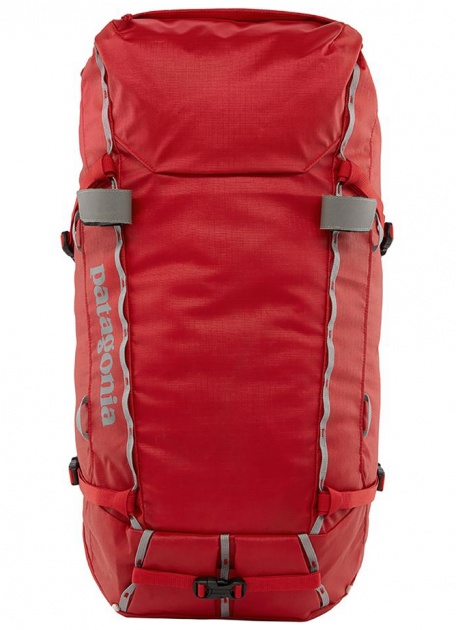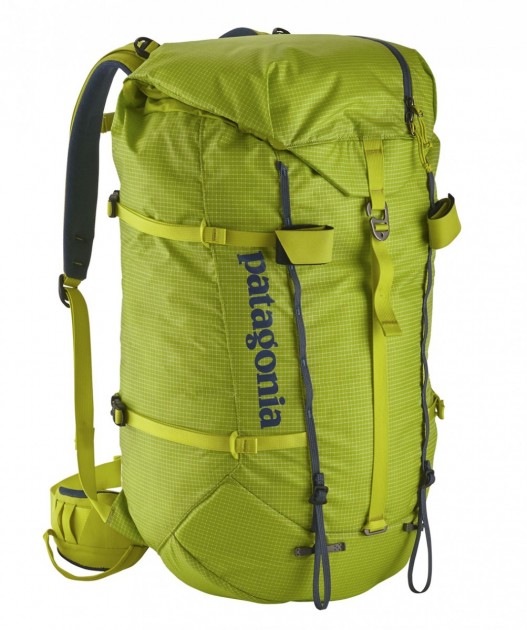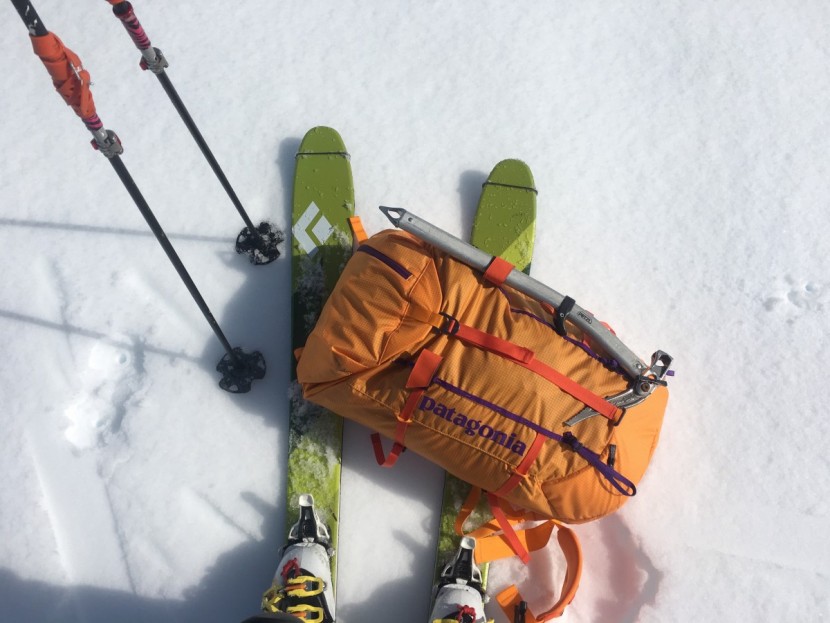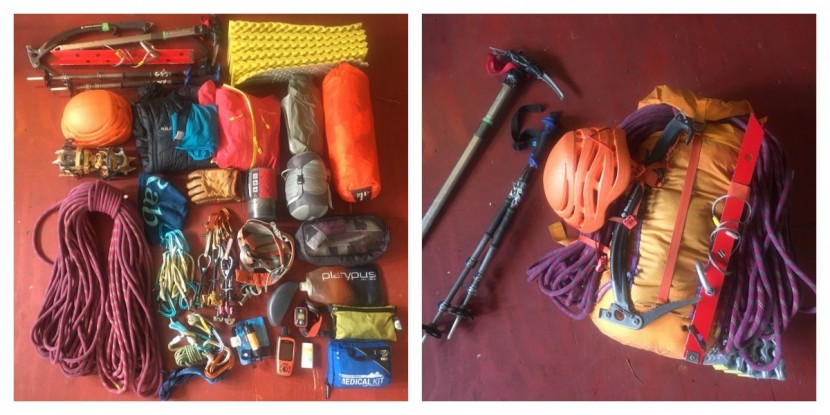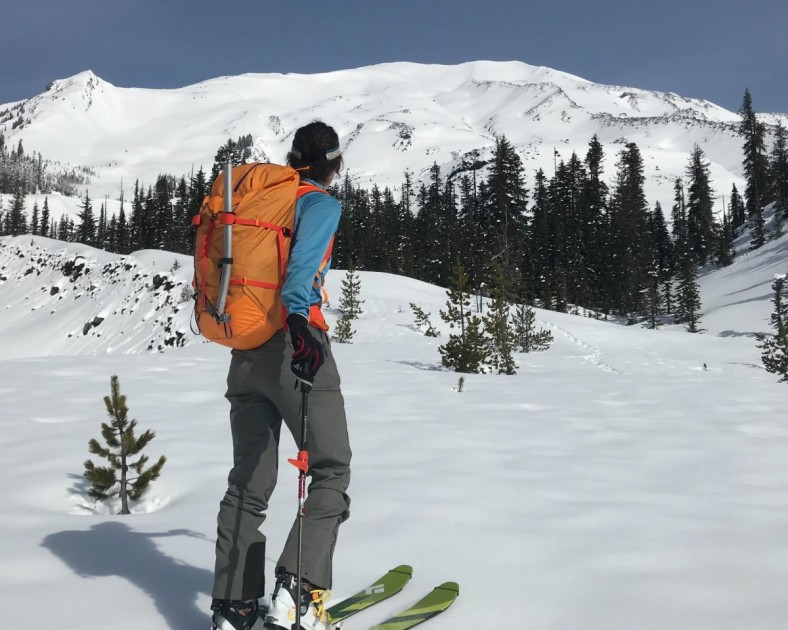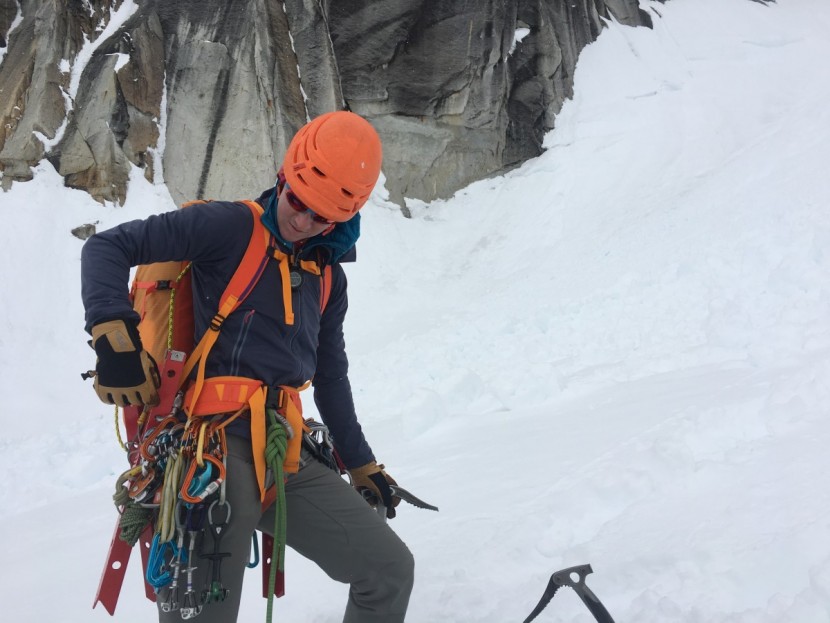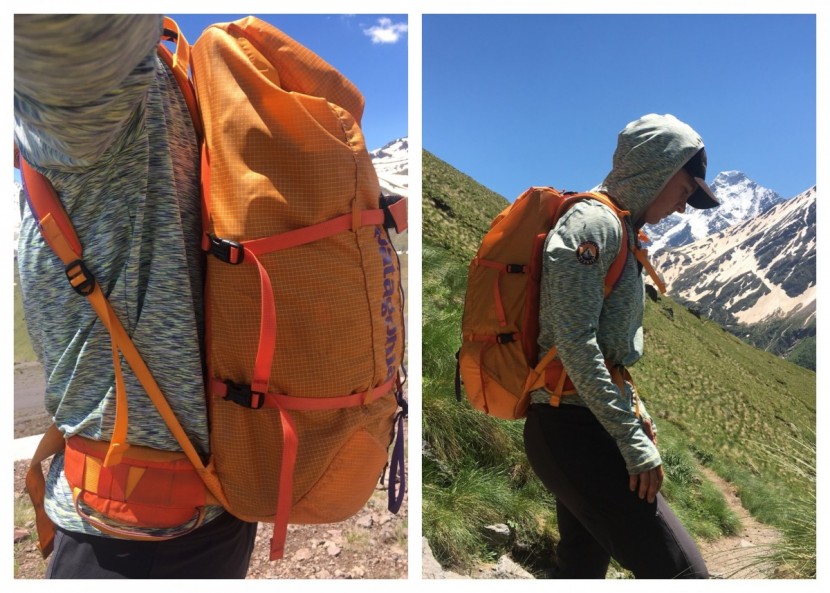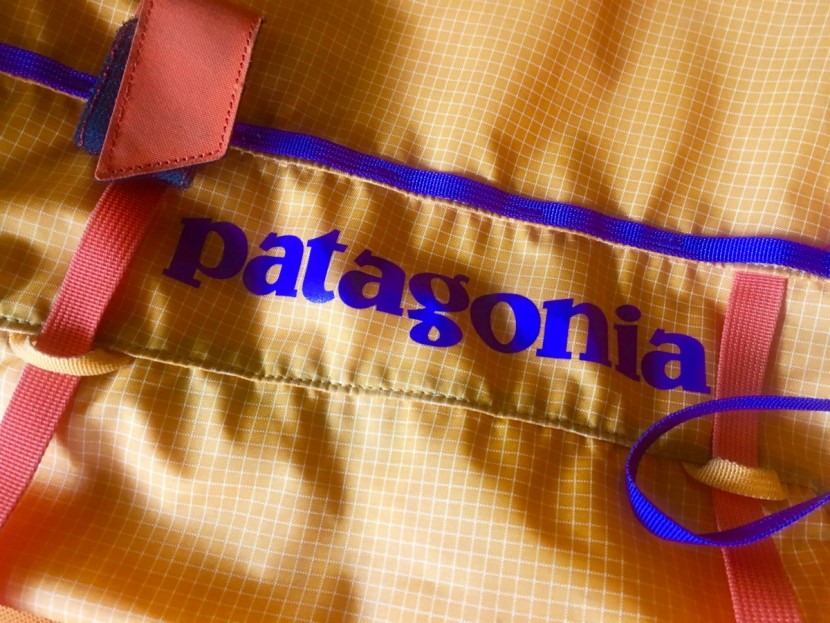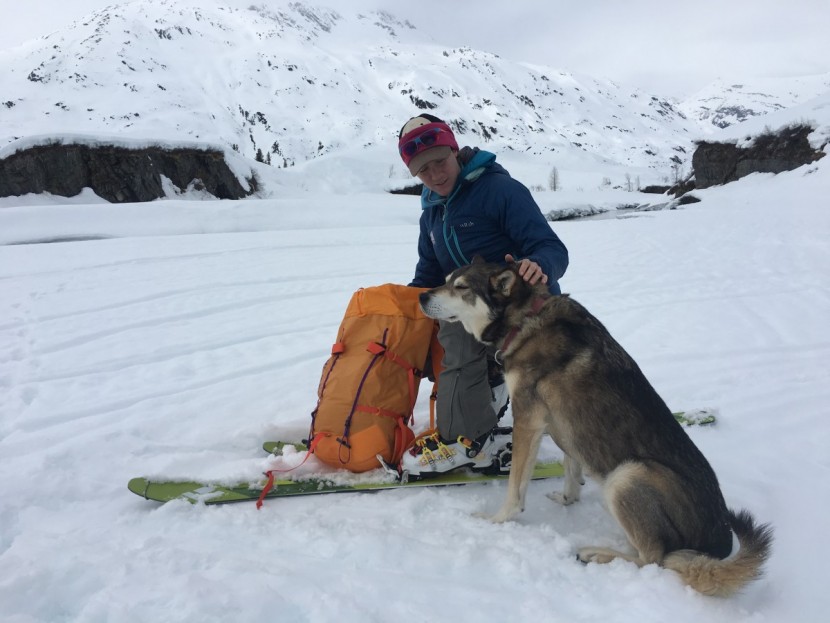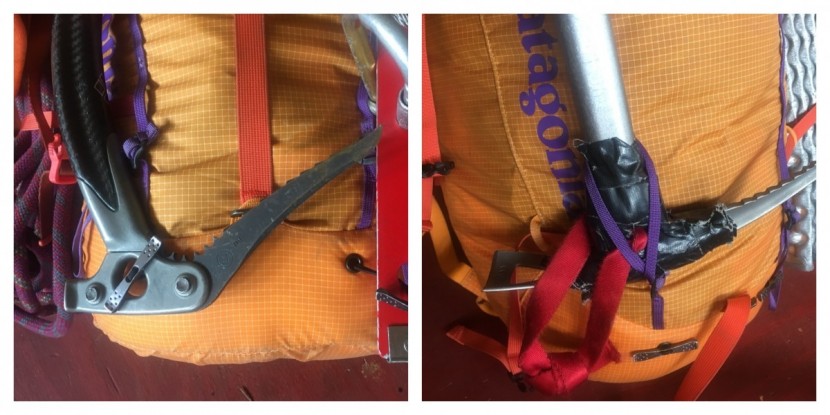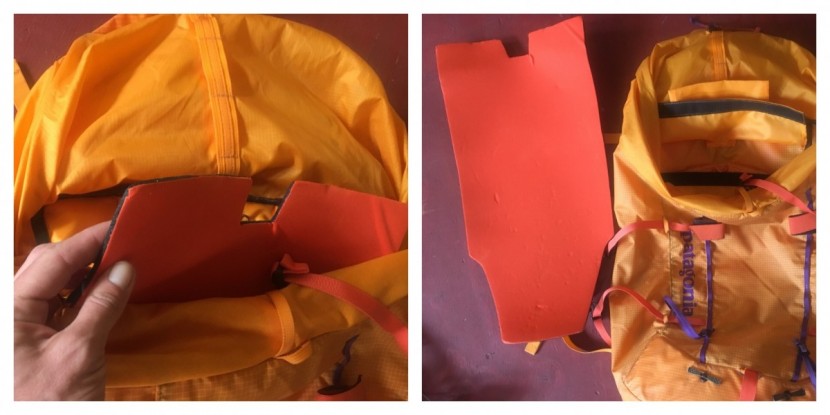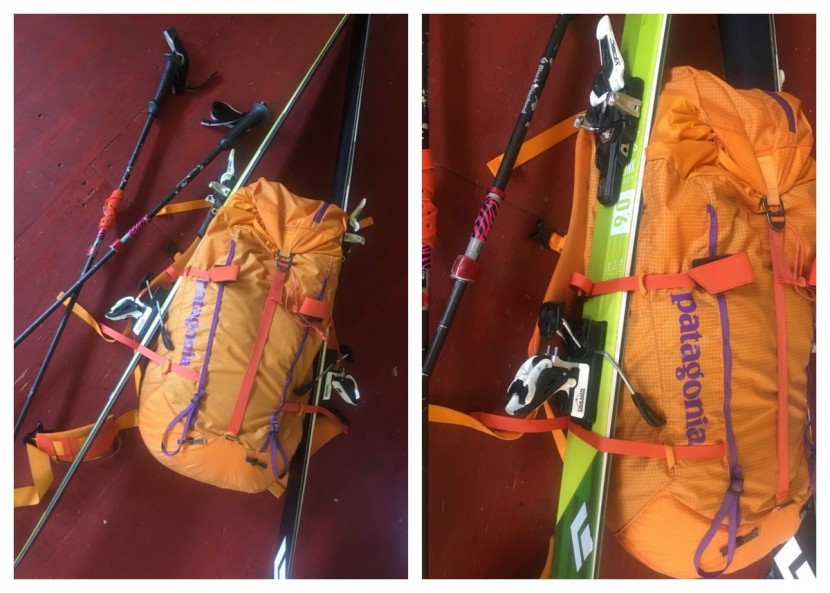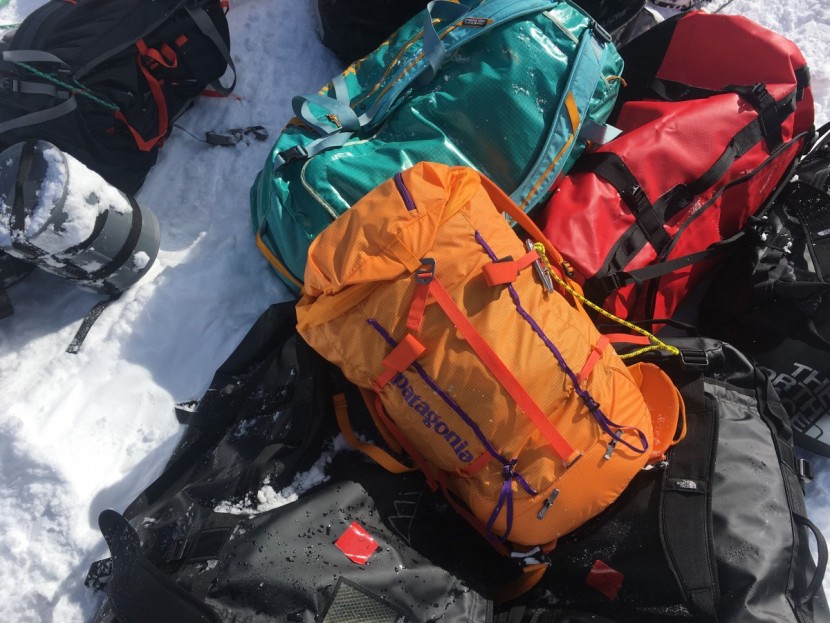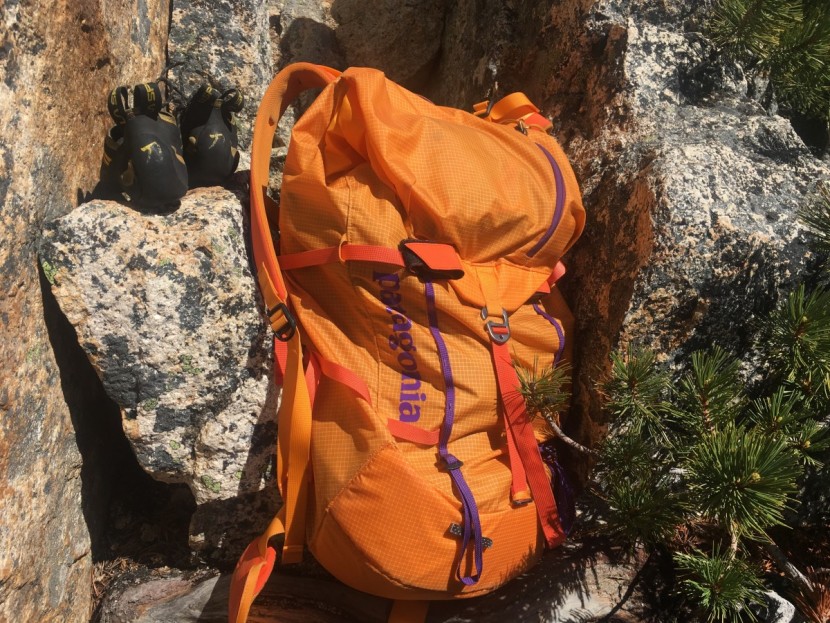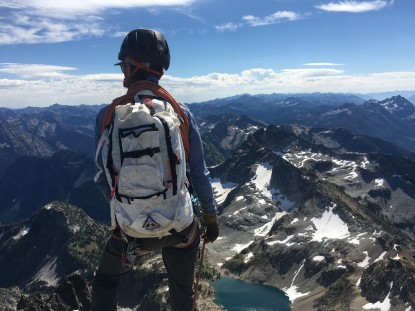Patagonia no longer makes this Best Buy winning pack in a 40L version. They've tweaked some of the features and now offer a 35L and 55L model. Details to follow.
March 2020Patagonia Ascensionist 40 Review

Our Verdict
Our Analysis and Test Results
Ascensionist 35L vs. Ascensionist 40L
Since our testing period with the Ascensionist, Patagonia has released some updated models. Our Best Buy winner is now available in a slightly smaller 35L version and a larger 55L version. The feature set is similar, though there are some differences between the designs. You can compare the two models below; the first image shows the new Ascensionist, followed by the model we tested.
We're now linking to the updated 35L model, but since we haven't actually tested that particular pack yet, be aware that the text below only pertains to the 40L version we reviewed.
Hands-On Review of the Ascensionist 40
The Patagonia Ascensionist is a true master of the ascent. It is lightweight, simple, and highly versatile, offering a potential quiver-of-one pack if you prefer shorter climbs and day trips.
The Ascensionist 40 is a master of all climbing disciplines, designed for fast-and-light, one to three-day missions. Our ping-pong ball volume test measured only 35L, but the volume was enough to get us through most of our shorter objectives.
Weight-To-Volume Ratio
The Ascensionist is a very light pack for the amount of gear it can comfortably carry. It is made of lightweight 210 denier Cordura nylon, which is still strong and durable enough to handle our heavy and sharp metal climbing equipment.
We measured its volume to be true as advertised at 40 liters, and for a medium/large size, it weighed under 900 grams. This gave the Ascensionist a remarkable 22 grams per liter weight-to-volume ratio.
For similar climbing performance on route, check out the even more slimmed-down Black Diamond Blitz 28, our favorite on-route pack. It is less versatile than the Ascensionist, but performs a little better on steep climbs.
Comfort
The Ascensionist rated well above average for climbing comfort. It falls behind some of our other award winners, especially the Osprey Mutant — which offers groundbreaking carrying comfort—but not by much.
The hip belt was something we really liked on the Ascensionist. It is an excellent compromise between the Osprey Mutant and the Arc'teryx Alpha FL. It has firm, low profile foam pads that slide side-to-side. This means you can situate them to support a heavier load, and push them around to work better with a harness while climbing.
We think the Ascensionist is very similar to the Arc'teryx Alpha FL 45. But it's not quite as comfortable for its most common uses — i.e., lightweight alpine climbs. Both must be packed very well to be comfortable, but the Ascensionist is more forgiving when packed poorly. Still, the back panel would often buckle and bend when it wasn't full.
We could easily sort this out by arching our back and pushing things back into place if the contents were soft enough and there was still adequate wiggle room in the pack to move things around. Or, we could remove the back panel entirely for lightweight summit pushes. This made the pack carry very well on summer rock routes when the contents were lightweight and soft (mostly clothing, food, water). If you have any firm contents like a hard water bottle or a small stove for a bivy, you would likely still want the foam back panel in place.
The second reason this pack didn't quite outshine the Alpha FL is because the back panel came up higher around our shoulders and felt boxier on our back. This is a nit-picky detail, but these were both such excellent packs we had to be as discerning as possible.
Ultimately, the Ascensionist ranks higher than the Alpha overall. But, if you prioritize ultra-lightweight and comfort on the climb over all else, this might point you to the Alpha.
Durability
The Ascensionist proved to be a very well constructed, durable mountaineering pack. The first thing we examine for durability is the fabric. The pack is made of 5.5-oz 210-denier CORDURA® 86% nylon/14% polyester ripstop with a polyurethane coating, which is among the lighter materials in this review — but still a very durable fabric for use in the rugged mountain environment.
The fabric held up very well to abrasion, which was the Achilles heel of the Hyperlite Mountain Gear Ice Pack. Otherwise, these packs offer nearly equivalent lightweight comfort.
The Ascensionist also has a padded bottom which helps it stand up to repeated drops onto rocks (and also helps it stand up while you're packing it). The stitching never strained, even when overstuffed, and the small, lightweight buckles were still burly enough to hold up to long-term, regular use.
The Arc'teryx Alpha FL boast much more durable fabric, but it is also more of a niche pack due to the lack of features for general mountaineering purposes. This made the Ascensionist more of a go-to pack for more days on more objectives. The combination of durable materials, solid construction, and added durability in key areas kept us confident during long days in a wide variety of mountainous terrain.
The pack's suspension system and haul loop are integrated in a way that reinforces them and makes them very strong. In our testing, we pick up a fully loaded pack using just one shoulder strap to see if it showed any signs of strain. The Ascensionist proved remarkably strong, while other packs quickly showed signs of strain. Some even tore at the seams.
Versatility
The Ascensionist shines for its combination of lightweight, comfort, and excellent versatility. This pack was the answer to any of our hesitations when recommending the Arc'teryx Alpha FL. It is nearly as light and comfortable, but it is what we would call a fully featured alpine climbing backpack.
We could take the Ascensionist ice climbing, rock climbing, and ski mountaineering. (The Alpha does not accommodate skis without significant shenanigans.) Plus, it was light and compact enough, with excellent climbing features, to make it a go-to choice for our fast-and-light missions. It has traditional ice axe loops as well as T-bars for ice tools with a smaller head shape. If you don't need to carry ice tools or an axe, you can also remove the velcro loops that secure the shafts for modest weight saving and sleek simplicity.
The only pack that is even more versatile than the Ascensionist is the Editor's Choice winner, the Osprey Mutant 38. The Mutant does all of these things, but it is also easy to overstuff for longer trips. The Mutant also remains comfortable when carrying surprisingly heavy loads and strapping rope over the top of it all. We could take the Mutant on select missions up to 4-5 days in length, which is shocking for a “38-liter” pack.
You can overstuff the Ascensionist to an extent, but then you have to leave the lid splayed open, making the drawstring closure is much less secure.
If you move the outer cinching strap up and anchor it to the higher loop, you can secure a rope over the top of the bag and hook it to one of the daisy chain loops on the underside of the lid. However, because the pack's drawstring closure trends and cinches outward (not upward like the Arc'teryx Alpha FL), this pushes the rope out away from our backs more than we like for carrying comfort. This design was a little finicky for overstuffing purposes. But it could work in a pinch and might be worth it for the pack's climbing comfort when on route.
One small detail we did like over the Mutant, however, is the Ascensionist's wider opening. In terms of versatility, this meant we liked it much more for cragging because it was much easier to drop a full rack of climbing gear in the pack through the wider mouth.
Additionally, we can remove the foam framesheet for very lightweight summit pushes. This improved climbing comfort significantly, making the pack ride close and mold well to our backs for technical climbing. Note, this only works with a few lightweight layers, snacks and water for the route, and maybe an emergency bivy sack. The frame sheet can also serve as part of your sleeping system. Neither the Mutant or the Alpha allows this.
Features
This pack is the answer to those frustrated by the lack of features on the Arc'teryx Alpha FL. We loved the comfort, durability, and light weight of the Alpha, but we found it to be limited in application. Realistically, the Alpha is a phenomenal ice and alpine climbing pack, but we can't easily attach skis to it, and it was awkward for carrying pickets or anything else we wanted to strap to the sides.
Patagonia addresses these pitfalls with this Ascensionist, with a weight penalty of only about a half a pound. It has excellent lightweight side straps which easily carry your skis in an A frame style. The pack has ice axe loops as well as ice tool/piolet attachments that allow you to deploy your tools without taking the backpack off (so long as the handle can slide down through the velcro shaft loops). This is a big improvement over previous versions of the Ascensionist.
The pack closes easily with the pull of a cord, like a stuff sack. It secures with a cam locking buckle, which will only open with the pull of the separate, shorter cord in opposition to a separate loop. This means the pack will stay shut with the simple pull of a cord. You can further secure it with another cinching strap anchored at the bottom of the pack. It also features a small zippered pocket in the top of the pack. It's not quite a proper “brain” or pack lid, but it's roomy enough to be functional.
This is also a major improvement over the difficult-to-access front zipper pocket on the Alpha FL. The Ascensionist's drawstring opening style helps minimize excess fabric while ensuring a wide mouth opening. (If you remember the older versions of the Ascensionist with an awkward flap of fabric, you'll appreciate this clever new design.) All-in-all, it's very convenient, easy, and fast to operate.
The Ascensionis is very easy to pack with its wide mouth and a structured foam bottom that helps keep it open and upright. The pack closure style, similar to the Alpha, is not meant to be overstuffed. If you need to pack five-day trips into a small package and strip down (remove the lid) for fast and light ascents, check out the Editor's Choice winner Osprey Mutant 38.
The hip belt is highly adjustable with sliding pads that make it very easy to place them squarely on top of your hip bones. They also have gear loops, which are very convenient when climbing technical routes. You can technically remove the hip belt padding — but you'll probably have to cut the sewn fold at the end to slide the pads off. In all, we found it to be an excellent compromise between Mutant's support and the Arc'teryx Alpha FL's minimal style. It is supportive and comfortable for heavier loads, but easy to slide up above a harness if you just wanted it out of your way while climbing.
The Ascensionist also now features a hose hole for a hydration bladder and a vastly improved sternum strap. It has low profile clips that are easy to shift lower or higher. They can also slide about an inch up or down for micro-adjustments while hiking or climbing.
Best Applications
The Ascensionist is an excellent pack for fast-and-light day climbs and will accommodate lightweight gear for trips up to 3 days in length, more or less. We loved this pack for a wide variety of uses. It is especially great for traveling when you plan to climb, hike, and maybe even ski. If you're road-tripping for the spring, this is the pack that will likely see the most use, so it'll be worth the space it takes up in your campervan, truck, rocket box, or car. But then again, it lays flat and is so lightweight it hardly takes up any room at all.
This is a pack that can replace as many as three in your quiver. It can climb, ski, crag, hike, and even works well as a carry on for airline travel.
Value
The Ascensionist is an excellent value at $179. It is highly versatile, impressively durable, and comfortable on a variety of mountain missions. It is more affordable than many packs in its size range, making it a very impressive pack for the price.
Conclusion
The Ascensionist climbed nearly to the top of this review, missing the Editor's Choice award by a very slim margin. If it were easier to overstuff and still comfortable to carry, it would surely have outpaced the Osprey Mutant in this round of testing. As it is, this is an excellent pack for mountaineering — whether with ice tools, ice axe, or skis — for trips of about three days in length or less. We loved the versatility, lightweight, and carrying comfort. If you're looking for a quiver-of-one pack for short trips, this is an excellent choice.



